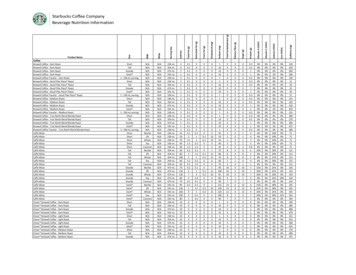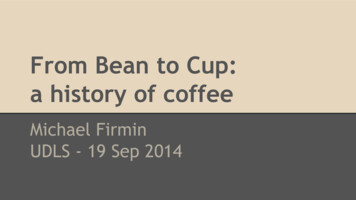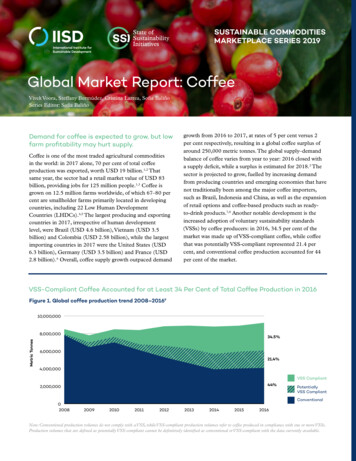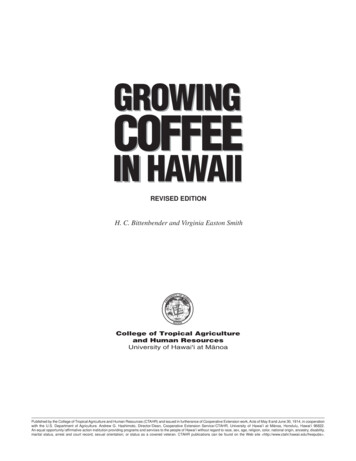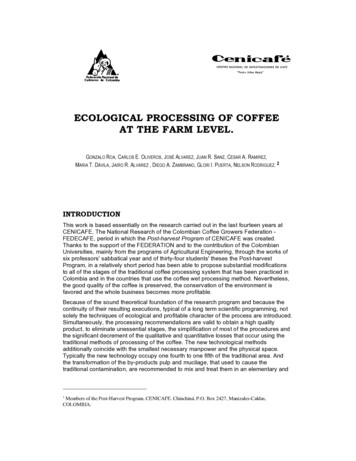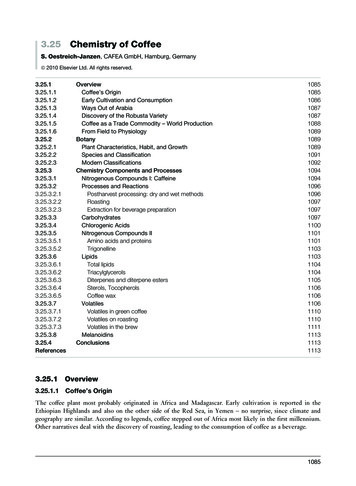
Transcription
3.25Chemistry of CoffeeS. Oestreich-Janzen, CAFEA GmbH, Hamburg, Germanyª 2010 Elsevier Ltd. All rights eferencesOverviewCoffee’s OriginEarly Cultivation and ConsumptionWays Out of ArabiaDiscovery of the Robusta VarietyCoffee as a Trade Commodity – World ProductionFrom Field to PhysiologyBotanyPlant Characteristics, Habit, and GrowthSpecies and ClassificationModern ClassificationsChemistry Components and ProcessesNitrogenous Compounds I: CaffeineProcesses and ReactionsPostharvest processing: dry and wet methodsRoastingExtraction for beverage preparationCarbohydratesChlorogenic AcidsNitrogenous Compounds IIAmino acids and proteinsTrigonellineLipidsTotal lipidsTriacylglycerolsDiterpenes and diterpene estersSterols, TocopherolsCoffee waxVolatilesVolatiles in green coffeeVolatiles on roastingVolatiles in the 11111113111311133.25.1 Overview3.25.1.1Coffee’s OriginThe coffee plant most probably originated in Africa and Madagascar. Early cultivation is reported in theEthiopian Highlands and also on the other side of the Red Sea, in Yemen – no surprise, since climate andgeography are similar. According to legends, coffee stepped out of Africa most likely in the first millennium.Other narratives deal with the discovery of roasting, leading to the consumption of coffee as a beverage.1085
1086 Chemistry of CoffeeTropicEquatorEquatorTropicCoffee producing countries 2009 (ICO statistics and others)Arabica prevailing (more than 75 %)Robusta prevailing (more than 75%)Intermediate Arabica/Robusta shareFigure 1 Coffee producing countries around the globe.Coffee grows best in areas lying between the tropics. Today, it is found in all continents belonging to thisgeographic belt, Figure 1, even in Australia and very recently, not yet shown here, at the Northern tropic in theYunnan highland of China. There are two main species of coffee, Arabica and Robusta, each with its own ecology.3.25.1.2Early Cultivation and ConsumptionThe first reference to coffee in the literature seems to be from Arab scientists in the ninth and tenth centuries (Rhazes,Persian physician (853–935); Avicenna, Arab physician (980–1037), polymath in the world of letters and sciences).Referenced to as ‘bun’, it was a stimulant food of Ethiopia and Yemen. It might have been chewed and eaten.The oldest material source is dated about AD 1200. Carbonized paleobotanic Arabica coffee beans werefound in 1997 in an archaeological excavation1 on the eastern side of the Arabian Peninsula, near Oman,together with the early thirteenth-century pottery from Yemen. Since these beans were evidently not at theirgrowing place, they indicate that coffee was traded at that time. The findings also reveal that the beans camefrom Yemen and people knew about roasting them.2Until 1600, the cultivation of coffee was restricted to Arabia, and mainly centered in the highlands of Yemen,where a sophisticated system of irrigation was practiced.3 To retain this monopoly, the export of coffee plantswas strictly forbidden, and even the beans for trade were said to have been made infertile.Coffee was economically important for both producers and traders. The Arab Islamic world was familiarwith the beverage, even though there were times of restriction, based on whether or not religion permittedconsumption of the beverage.4 Mecca pilgrims took word of the beverage to their distant homelands.The use of coffee spread with the Ottoman Empire, over its part of the Mediterranean. Coffee brewersprogressed into a specialized guild, as reported by Austrian legation members about a procession of guilds at acelebration in Istanbul in 1582.5Detailed information on coffee reached the Christian part of Europe about the same time, through travelreports of scientists6,7 and books’ prints with drawings of the plant and descriptions of its consumption. The
Chemistry of Coffee 1087naked beans had circulated among European scientists some time before, mentioned in the updated 1574edition of an earlier standard work on tropical plants.8Coffee as a commodity for trade did not enter the non-Islamic world until 1615, when a few bags arrived inVenice,9 followed by demand and supply. The coffee trade’s mainstream ran from Mocha, the port in Yemeninvolved in export, through ship and caravan to Cairo and Alexandria.4 From there the coffee was distributed tothe Ottoman customers and to the consumers in Europe, where coffee houses started flourishing. As early as1668, coffee had crossed the Atlantic and arrived in Dutch New York.103.25.1.3Ways Out of ArabiaDespite all of the protective restrictions adopted in the Arab world, the expanding interest in the beverageencouraged a search for a similar tropical climate for growing coffee plants and efforts to find ways oftransferring plants. Possibly, the first expansion was to the west coast of India, where coffee was brought inby Muslim pilgrims from Mecca. The mystical origins of Indian coffee are traced to the seven beans brought toKarnataka by the legendary Baba Budan in 1600.11,12From India, coffee is reported to have moved to Ceylon (now Sri Lanka) in 1658, to the plantations of theNetherlands East India Company, and to Java after 1696.13 Java became the world’s mass supplier for coffeeoutside Arabia and remained so for half a century; even today, in the United States, a cup of coffee is commonlycalled a ‘cup of Java’.From the Dutch colonies, single plants were sent to the botanical garden of Amsterdam in 1706; from there,living plants were transported to the Dutch colony in Surinam for cultivation and a grown-up tree was gifted toKing Louis XIV in Paris in 1714.14 Some plants of the next Parisian generation were transferred to Frenchcolonies in the Caribbean, for cultivation in an appropriate climate. There is a well-known textbook story of asingle plant surviving on a ship to Martinique, nourished by the drinking water of its officer, in about 1720. Thiswas reported by the officer himself 50 years later15. The coffee variety originating from Amsterdam, calledTypica, made its way step by step into Latin America.At the same time, there was another route of Arabica plants out of Yemen: 60 seedlings, an official present bythe Yemenite sultan16 to Louis XIV, were sent to the French Bourbon Island (La Réunion, today) in 1715; again,these were a limited number of plants. From there, the Bourbon variety of coffee entered the French colonies inthe Americas and in other places.Coffee cultivation was also promoted by other colonial powers such as Portugal, Spain, and England (and,for a few decades, by Germany also). These powers also expanded cultivation to their respective spheres ofinfluence.Bourbon and Typica are the prolific ancestors of most of today’s Arabica crops – a genetically narrow routethat expanded from a few single plants to millions of tons of Arabica per year, all within 300 years.Other coffee types, which grew without international demand in the humid tropical areas of their origin,became objects of scientific surveys and explorations from the eighteenth century.Today, independent coffee producing countries cooperate with the consuming ones in a worldwide researchfor the conservation of the coffee plant’s genetic heritage and diversity. Numerous so-called wild or spontaneous varieties deserve genetic resource management. Since they are imminently threatened by advanceddeforestation, an effective preservation strategy is needed.3.25.1.4Discovery of the Robusta VarietyThe tropical areas of Africa, from Guinea to Angola and to Uganda in the east, host different species of coffee.The first to gain economic importance was the Ethiopian Arabica, with its early cultivation in Arabia.Reports of other species in Africa and their indigenous cultivation and trade date from the nineteenthcentury. For the East African countries, expeditions of 185717 and 186218 informed that coffee was familiar tothe people there, grown in homegardens,19,20 and chewed and eaten as green bean for its stimulating effect.21,22Discussions on the identity of these species of coffee, whether they were wild Arabicas (prospector’s hope) orsui generis, remained ongoing23 till 1897. Several non-Arabica species were determined by Froehner,24including Coffea canephora Pierre,25 with the later extension ex A. Froehner.
1088 Chemistry of CoffeeCultivation of this species for use as roast coffee was initiated in 1898,26,27 and promoted by a Belgianhorticultural company.28,29 This coffee was called Robusta by the Belgians as it proved more robust against diseasesand had less ecological requirements in terms of humidity, temperature, and altitude of plantations. Althoughdifferent in taste, it soon turned out to be a useful alternative for the vulnerable Arabicas, which were disease pronedue to their narrow genetic origin.30 There was an actual demand for resistant plants as a disastrous epidemic of leafrust, caused by the devastating Hemileia vastatrix fungus, started in 1869.31 The first to suffer from it were the Ceyloncoffee plantations. There, at the abandoned plantations, coffee was replaced by tea. The next coffee countries soon tobe attacked were India and, then, Indonesia. Eventually, the search for rust-resistant coffee types led to thesubstitution of Arabica by Robusta, after an intermezzo with the species Coffea liberica. During the last century,Robusta made its way to other coffee growing regions and witnessed an enormous expansion in its cultivation.Besides pests and diseases, coffee crops can also be reduced by drought and frost,32 thus influencing theavailable volume of coffee. This happened regularly after a frost in Brazil, causing declines in world supplies inthe 1970s. Soon the cultivation of Robusta increased in West Africa, its original homeland.Since 1990 there has been a steady increase in Robusta production in Vietnam, which is now the world’s ofcoffee in general.333.25.1.5Coffee as a Trade Commodity – World Production7 000 0006 000 000Production per year (tons)The data of total coffee production since 1620 show the overall increase and the rise of new production areas.Compiled from several sources, these data are represented as a graph (Figure 2), with the volume of today’s bigplayers marked individually.VietnamColombiaBrazilIndonesiaOthers5 000 000World coffee production in the last centuries- compilation from different sources -Total25 years average4 000 0002 000 0001 000 000ColombiaBrazilIndonesiaHaitiYemen3 000 000Selected originsof early production500 00001 000 80194019551970Figure 2 World Coffee production compiled from several sources.A.B.C.D.E.F.G.1620, 1700: Becker,34 p 11.1670, 1955: Söhn,35 pp 11, 98.1720: Eccardi; Sandalj,9 p 48.1789, 1936: Dahlgren,10 pp 22, 41.1800–1920, 1940, 1950, 1960, 1975: Sivetz,36 pp 13.1980–1995: ICO,33 historical data, total production of member plus non member countries (2009).2000–2008: ICO,33 world supply, total production (accessed July 2009).198520002008
Chemistry of Coffee 1089The known data for world coffee trade started with about 10 000 tons per year in 1700,34 all from Yemen,followed by supply from Indonesia and from the Caribbean.35,37 In 2008, a total of about 8 000 000 tons wastraded (roughly, Brazil 35%, Vietnam 15%, Colombia 10%, and Indonesia 5%, followed by Ethiopia, Mexico,and India; Arabica constituted 60%). The world production figures are likely higher because there is domesticconsumption as well. The volumes of world coffee production and trade before the seventeenth century is notclearly reported; compared with the volumes of today, it was negligible.3.25.1.6From Field to PhysiologyCoffee passes through several steps to reach its final destination: human consumption. All of these steps – theseed maturation, postharvest processing, storage and transportation on land and ship, roasting, home brewing orindustrial extraction, and eventual intermediate treatments – have an impact on its chemical composition.The economic importance of coffee is evident in agriculture, occupation, and welfare both in producing andconsuming countries. Production, international trade, and world wide consumption create normative rules in legislation, administration and standardization in the countries concerned, regarding registration, food surveillance, customs,subsidaries, analytical methods, and many other aspects. Coffee’s agriculture has an impact even on the global ecology.Originally, coffee’s stimulating property, its oldest-known physiological effect, was the basis of its use; lateron the focus shifted to enjoying aromatic roast coffee beverage as a psychoactive stimulant. Today, due tosophisticated research on the effects and mechanisms of action of coffee, a more balanced view has emerged onthe effects of coffee on our well-being and health.3.25.2 Botany3.25.2.1Plant Characteristics, Habit, and GrowthIn nonrestricted growth, the coffee plant is a perennial tree or treelet with a single main trunk and horizontal branches,primary, secondary, and tertiary horizontal branches (plagiotropic); pruning can lead to multiple-stem plants.Coffee’s original place is the forest understorey. Coffee plants bear clusters of flowers and cherry-like fruits.A short central taproot fades into axillary and lateral roots and a manifold of feeder bearers and root hairs. Thedark green elliptical leaves grow in opposite pairs on the main stem and branches. The wood is dense; the fruits,nectar, and leaves are food resources.Under tropical conditions, flowering and fruiting happen in parallel; the nearer coffee plants are to theequator, the more pronounced is a bimodal cycle.Multistem growth is trained by either capping the main stem, giving rise to suckers that develop into newvertical stems with horizontal branching, or bending the principal stem to the horizontal (agobiado technique),with several suckers in a row.Periodic pruning is done to optimize the plant shape for good fruiting, easy harvesting, and effective diseaseand pest control, as well as to rejuvenate the plant.Pests may attack the plants in the field and the beans in store by boring, biting, mining, and sucking, or livingas parasites on the root system; fungi, viruses, and bacteria may cause severe coffee diseases.Further characteristics and figures are given in Table 1. For each characteristic, the properties common toall species are written in the first line, followed by the differing ones beneath in separate columns for the species.The development of flowers from the buds takes several weeks, that of the fruits several months afterflowering, with periods of growth and of dormancy. The sequence of steps is enzymatically controlled in-plantand is triggered externally by photoperiodism, relief of water stress, and temperature drop.In a days-after-flowering (DAF) scale,43 depicted in Figure 3, the tissues of the growing fruit show markedchanges in volume ranking of all pericarp, perisperm, and endosperm. Embedded in the start-up pericarp, theperisperm expands to equal the pericarp mass; then, it gets absorbed by the developing endosperm, the finalorgan for all storage compounds in the fruit.Propagation to the next generation starts with either seeds from the farmer’s own plants, sown directly in thefields, or seedlings from seeds or cuttings delivered by a nursery in plastic bags for planting. Development timein soil from the naked seed to the first leaves is 1–2 months at best. A third method for propagation in vitro is
Amphidiploid(2n ¼ 4 ¼ 44 chromosomes)Coffea arabicaDiploid (2n ¼ 22 chromosomes)Coffea canephoraPaired, axillary; best flowering at 1-year-old wood; development time 4 months with periods of dormancy4–12 with 16–48 flowers per node30–100 flowers per nodeHermaphrodite; corollas white or rarely light pink; corolla lobes overlapping; anthers exerted; style long, exertedAutogamous (self-pollinating)Allogamous (cross-pollinating)Time for pollination 1 dayReceptive to 6 days after floweringBerry containing two seeds (rarely one or three); each seed with a deep groove, an invagination, on the flat ventral side (‘coffee bean’).Length 12–18 mmLength 8–16 mmFruit maturation 7–9 months afterFruit maturation 9–11 months after floweringC.racemosa: 2 monthsfloweringFlowersFruitThe table is compiled from several sources.24,38–42LeavesInflorescences1.2–2 mC.liberica up to 18 m; also 2 m dwarfspeciesOthersTap root 0.5–1 m; several axillary roots, vertical depth 1.5–3 m; many lateral roots parallel to the soil, distance 1.5–1.8 m from the trunk;hair roots overall; 90% of the root system in the upper 30 cm of the lateral partsDeeper rootsShallower rootsElliptical; margin entire; tip accuminate; dark green to bronze greenLength 10–15, width 4–6 cmLength 22, width 17 cmDevelopment time 7–8 weeks to full expansion and optimum photosynthesis (Arabica);life span 7–10 months (Robusta)1.2–2 mHumid, evergreen tropical forest (cultivation with and without shade trees; intercropping)tropical highlands, (950–)tropical lowlands. (50–)250–1500 m1200–1950 mTemperature: moderate, 15–24 CWarm, 18–36 CRainfall 2200–3000 mm year 1Rainfall 1200–2200 mm year 1Exceptional cultivations at sea levelSometimes in seasonally dry humid forest, or in(Hawaii)gallery forest4–6 m (pruned 2–3 m)8–12 m (pruned 2–3 m)CoffeaRoot systemCanopy diameterPlant heightEcologyChromosome statusSpecies CharacterTable 1 Coffee characteristics and requirements for cultivation
Chemistry of Coffee 1091FloweringPerisperm phaseEndosperm developmentArabica 7–9 monthsRobusta 9–11 monthsPericarp maturation250 DAF300 DAFFigure 3 Fruit development in coffee, days-after-flowering scale, compiled from several sources. A. Flower: Linnaeus,46p 1. B. Bean development: De Castro; Marraccini,43 p 177.used in research: the cultivation of a fragment of tissue from a plant in a suitable substrate, producing a newplant that is genetically identical to the plant from which it originated.443.25.2.2Species and ClassificationThe first attempts at coffee classification were as early as 1623, when Bauhin45 in his Pinax theatri botanici(Illustrated exposition of plants) mentioned Coffea and set it in relation to Evonymus.A century later, a comprehensive descriptive systematization was proposed by Linné; he set up plant classeswith easily identifiable characters of the floral structure, including the genus Coffea, at the very beginning,46,47with publications in 1735 and 1737. The final naming of the species as Coffea arabica was presented in his ‘SpeciesPlantarum’ in 1753.48 This work was based on direct observations in botanical gardens and herbaria,49,50 and indiscussions and exchanges with colleagues. He explicitly cited Jussieu’s description of coffee for the RoyalAcademy in Paris in 1713/1715.14In Figure 4 shows the coffee of Linné’s original private herbarium, pressed, dried, and fixed on a sheet(N 2490 of the Linnaean Herbarium at the Linnean society London, Salvage No. 232.1; the mark ‘‘india’’presumably indicating the origin of the specimen; collection purchased from Linné’s widow in 1784).The official reference for C. arabica L. is the type specimen from Clifford’s herbarium,51 which Linnéhad described in 1737.49,50 It is designated as a lectotype52 on the basis of the procedures of theInternational Botanical Code (the Vienna Code of 200553). ‘Lectotype’ means that the first publisher haddescribed the specimen prior to the reference to it – the requirement to explicitly design a referencespecimen came up later.Linné’s typification became a benchmark for the botany of that time, as underlined by the title ‘Orderout of Chaos’ for an anniversary book of 2007.54 Although his classification was soon overtaken,55 thebinomial principle of naming remained – the first part indicates the botanic genus; the second is an epithetgiven by the first author, who is indexed. The overall genus for the coffee species is Coffea L., indexed asnamed by Linnaeus. The principal commercial species used for beverage preparation are C. arabica L., andC. canephora Pierre ex A.Froehner,25 commonly called var. Robusta. Coffea liberica Bull ex Hiern and someother species are much less important today; there are numerous varieties, including cultivated ones(cultivars).The botanical classification of coffee has reached a high degree of consensus, presented in internationalconferences56,57 and with ongoing publication in the World Checklist of Rubiaceae58 – coffee is positioned inthis family since Jussieu 1789.55Chevalier’s system,59 with four subgenera of Coffea, was popular for some decades of the last century.However, it became obsolete the more taxa of the different pools of coffee origin were described andclassified.60–62In terms of the Botanical Code, the classification lineage of coffee, starting at the family rank with Rubiaceae,goes down via subfamily Ixoriadeae, tribe Coffeae DC.,63,64 to the genus Coffea L. Some 100 accepted species ofthe genus, belong to the subgenus Coffea, including all beverage coffees; subgenus Baracoffea holds about 10species.42 That is the actual status.Nevertheless, there are follow-up refinements.65
1092 Chemistry of CoffeeFigure 4 ‘Caffe’ in Linnés herbar, marked ‘arabica’ by his own hand, courtesy of the Linnean Society, London.3.25.2.3Modern ClassificationsThe changes in classification since Linné’s time came along with a change of characterizing properties and ofobservables, morphological characters against molecular phylogenetics. Involved is a change in the philosophyof systematic biology, ‘‘from being considered a plan in the mind of the creator, . . . finally to a phylogeneticmapping of the tree of life’’.66 Recently, a ‘phylocode’ had been proposed, to substitute the Botanical Code’ssystem with its taxa and their hierarchy, at least partially.67 Discussions are under way.Modern analytical chemical measurements can now be used in combination with chemometric comparisonof secondary plant metabolite levels such as caffeine or chlorogenic acids to classify varieties in phylogenetictrees. Studies of the molecular genetic variation help to identify the relationships of species help to identifytheir relationships, presented in dendrograms and resulting in genetic clusters of coffees, which can becompared to the biogeographical grouping of coffee clades. Several lineages with geographical or ecologicalcoherence are now recognized,68 as shown in Figure 5.The phylogenetic approach widens the principles of classification from the morphological similarity ofexisting plants toward an evolutionary dimension, with genetic clades, where the taxa are traced back toancestry.With these instruments, the genetic origin of C. arabica could be investigated, with a strongly supportedhypothesis: Arabica seems to have been formed by interspecific crossing of diploid progenitors, one speciesclose to C. eugenioides as the maternal and another species close to the canephoroid group as the paternal
Chemistry of Coffee 1093Figure 5 The tropical African origin of coffee, distribution map showing the location of groups of Coffea.progenitor. This might have taken place in East–Central Africa, very likely in the late Quaternary period.69Several mechanisms were discussed – how the new species moved from a tetraploid via progressive diploidization toward the amphidiploid, which it is considered to be now. With the adaptation to the tropical mountainclimate of Ethiopia, a low but continued natural selection may have occurred.70In contrast, the high genetic diversity found in the canephora branch of coffee encourages an earlier dating ofthe origins, as some 500 000 years ago.71 The clustering of natural C. canephora diversity groups, with some 40species in continental Africa, supports the link to climatic variations in that tropical zone. In the last glacialmaximum, an arid period 18 000 years ago, the environment became hostile and few forest refugia72 remained.There, the differentiation of disseminated subgroups could have occurred,73 with rare migration of speciesalong the rivers74 and with unpopulated gaps in-between due to adverse conditions. From the East Africangroup, a dispersal to Madagascar and the neighboring islands might have taken place. They show more than 50species of the genus Coffea, distinct from the continentals: no naturally occurring species is shared betweenAfrica, Madagascar, and the Mascarenes.42Not so far away in history emerged the question about the origin of Bourbon Pointu from Réunion,C. arabica ‘Laurina’ – whether it is a mutation of the Arabica introduced from Yemen or a result of crossingbetween this Arabica and the indigenous Café marron of the island. A combination of historical and modernanalytical research revealed that it is a very young mutant of the Yemenite Arabica that was introduced inRéunion.75The genomic era facilitates the understanding of coffee seed development. Using current knowledge, themetabolic pathways of the major seed storage compounds of coffee were elucidated.76
1094 Chemistry of Coffee3.25.3 Chemistry Components and ProcessesCoffee, as internationally agreed by coffee people, means in the vocabulary ISO, the ‘‘fruits and seeds of plantsof the genus Coffea, usually of the cultivated species, and the products from these fruits and seeds, in differentstages of processing and use intended for human consumption’’ (subclause 1.1. of the ISO 3509 coffeevocabulary),77 and in the wording of the International Coffee Agreement, the ‘‘beans and cherries of the coffeetree, whether parchment, green or roasted, and includes ground, decaffeinated, liquid and soluble coffee’’(Article 2 of the said Agreement).78 Both definitions describe ‘coffee’ in terms of a series of stages frommaturation to consumption.The composition of coffee varies with the species and with the step in the line. Table 2 gives an overview ofanalytical data.The data are averages from literature reviews,80 and from investigations executed in other analyticalcontexts,82 where the components of constituent groups had been individually determined and summarized.79The in-bean localization of distinct components during the development stages of growing and ripening ofthe coffee fruit had been observed with electron microscopy supported by tissue coloring. Consecutive paperspresented at conferences of association for the science and information on coffee (ASIC) since 1977 featuredimpressive findings:83 constituents had been distinguished in their cellular environment and their migrationsobserved.An integral view – arrived at through the use of modern instruments – of key biosynthetic pathways of themain coffee seed storage compounds was published recently.76 Readers may refer to this paper for the plantbiochemistry as that will not be further elaborated here.The following sections deal with the main components, caffeine, carbohydrates, chlorogenic acids, lipids,other nitrogenous compounds, volatiles, and melanoidins, and include the transformation processes.The first compound covered here is caffeine, associated even by name to our subject, coffee. Caffeine is anitrogenous compound that is not affected by the central process in coffee chemistry, roasting.3.25.3.1Nitrogenous Compounds I: CaffeineCaffeine, 1,3,7-trimethyl-xanthine, a purine alkaloid, is a secondary metabolite of the coffee plant: thebiosynthesis starts from xanthosinemonophosphate.84 In the metabolic pathway, subsequent methylationsteps occur with different N-methyl transferases, methionine being the methyl donor. The purine catabolismof caffeine comprises its degradation via successive demethylation down to carbon dioxide and ammonia.85Table 2 Chemical composition of coffee, mass percent in dry matter, different uent% DW% DW% DW% DW% DW% DWCaffeineTrigonellineCarbohydratesChlorogenic acidsLipidsAmino acidsOrganic acidsMelanoidinsVolatile aromaAsh (minerals)Otherspartly 25.40.14.5In melanoidines2.40.3c423.811.07.52.625.90.14.7Added 66.07.928.68.07.4aLeloup79.Illy and Viani80.cMacrae81b
Chemistry of Coffee 1095In the coffee plant, caffeine is present in all parts over the ground. The ecological effects of caffeine as anintrinsic chemical defense against herbivory, molluscs, insects, fungi, or bacteria86 have often been discussed,but experimental results for clear support are difficult to obtain.87OCH3N12O63CH354NN789NCH3CaffeineCaffeine biosynthesis takes place in the leaves and in the pericarp, the outer part of the fruit. In aged leavesthe caffeine content is lower.88 In the pericarp tissues, light strongly stimulates the methylation step of caffeinesynthesis. When the seed inside the fruit starts growing, caffeine is translocated through the membranes andaccumulates in the endosperm. There, the final value is reached 8 months after flowering.89The caffeine content of the coffee beans depends on species and variety, from 0.6% in Laurina up to 4% insome extreme Robustas; averages are given in Table 3.90Not included here are coffees from the Mascaracoffea group of Madagascar, which do not belong to the‘beverage’ coffees.91 They have very low caffeine contents at the limit of analytical detection (caffeine free)92 andmay serve as genetic resources for further work. These low caffeine species also show low caffeine in their leaves.93The caff
The coffee trade’s mainstream ran from Mocha, the port in Yemen involved in export, through ship and caravan to Cairo and Alexandria.4 From there the coffee was distributed to the Ottoman customers and to the consumers in Europe, where coffee houses started flourishing. As early as 1668, coffee

